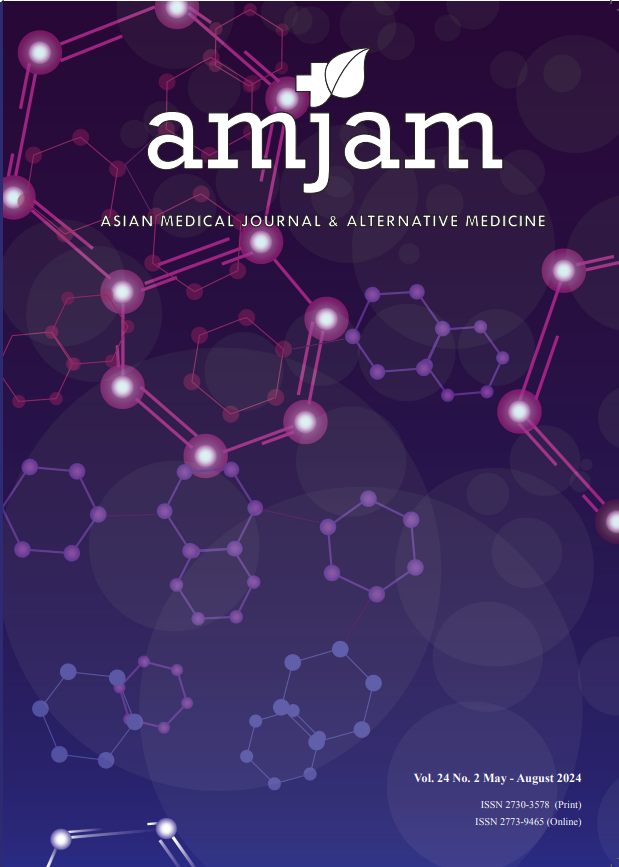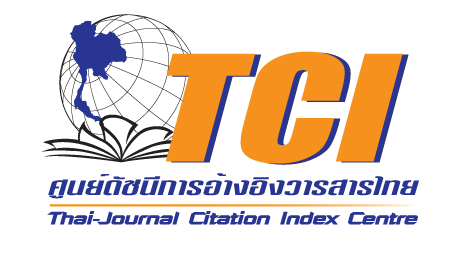Antioxidant and Anti-inflammatory Activities of Ethanol and Aqueous Extracts in the Amnouy Suksomjit’s Thai Folk Remedy
Keywords:
Antioxidant Activity, Anti-inflammation, Thai Folk Remedy, Antioxidant Compound, Nitric OxideAbstract
Introduction: A Thai folk remedy is traditionally used to manage many diseases, such as diabetes mellitus, hyperlipidemia, and dementia, as they are related via oxidative stress and chronic inflammation pathways.
Objectives: This study investigates the antioxidant contents, and anti-oxidation and anti-inflammation properties of ethanol and aqueous extracts of Dr. Amnouy Suksomjitʼs Thai folk remedy (RM or the Remedy).
Methods: RM and its plant ingredients were extracted with ethanol maceration and water decoction. All extracts had their antioxidant compounds measured i.e. total phenolic contents (TPC) and total flavonoid contents (TFC), activity by DPPH, ABTS+ and FRAP assays, and anti-inflammatory activity by determining the inhibition of nitric oxide (NO) production in LPS-induced RAW264.7 macrophage cells.
Results: The total phenolic contents, measured by TPC assay, for ethanol RM extract (RME) and water extract of the remedy (RMW) were 25.06 and 24.26 mg GAE/g Extract, respectively. Additionally, the flavonoid contents, determined by TFC, were 87.26 and 85.27 mg QE/g Extract for RME and RMW, respectively. RME and RMW exhibited antioxidant activity, with DPPH IC50 values of 56.69 and 46.35 μg/mL, and FRAP values of 20.28 and 13.07 µM TE/g Extract, respectively. RME and RMW showed no anti-ABTS+ effect. Furthermore, RME demonstrated a significant anti-inflammatory effect by reducing NO production in lipopolysaccharide (LPS) induced cells, with an IC50 value of 37.68 μg/mL, compared to prednisoloneʼs IC50 value of 51.45 μg/mL. Conversely, RMW did not exhibit any anti-inflammatory effect.
Conclusions: The ethanol and the water extracts of the Remedy showed antioxidant effects as found in the phenolics and flavonoids. However, only the ethanolic extract exhibited anti-inflammatory activity. These results support the use of the Remedy for treating diseases related to oxidative stress and inflammation pathways.
Downloads
References
Chen GL, Fan MX, Wu JL, Li N, Guo MQ. Antioxidant and anti-inflammatory properties of flavonoids from lotus plumule. Food Chem. 2019;277:706-712. doi:10.1016/j.foodchem.2018.11.040
Rodwattanagul S, Nimlamool W, Okonogi S. Antioxidant, antiglycation, and anti-inflammatory activities of Caesalpinia mimosoides. Drug Discov Ther. 2023;17(2):114-123. doi:10.5582/ddt.2023.01002
Ali G, Neda G. Flavonoids and phenolic acids: Role and biochemical activity in plants and human. Journal of medicinal plants research. 2011;5(31):6697-6703.
Lee HS, Kwon YJ, Seo EB, et al. Anti-inflammatory effects of Allium cepa L. peel extracts via inhibition of JAK-STAT pathway in LPS-stimulated RAW264.7 cells. J Ethnopharmacol. 2023;317:116851. doi:10.1016/j.jep.2023.116851
Jongrungraungchok S, Madaka F, Wunnakup T, et al. In vitro antioxidant, anti-inflammatory, and anticancer activities of mixture Thai medicinal plants. BMC Complement Med Ther. 2023;23(1):43. doi:10.1186/s12906-023-03862-8
Yoon J-H, Baek SJ. Molecular targets of dietary polyphenols with anti-inflammatory properties. Yonsei medical journal. 2005;46(5):585-596.
Prasansuklab A, Tencomnao T. Acanthus ebracteatus leaf extract provides neuronal cell protection against oxidative stress injury induced by glutamate. BMC complementary and alternative medicine. 2018;18(1):1-15.
Olatunji OJ, Olatunde OO, Jayeoye TJ, et al. New Insights on Acanthus ebracteatus Vahl: UPLC-ESI-QTOF-MS Profile, Antioxidant, Antimicrobial and Anticancer Activities. Molecules. 2022;27(6). doi:10.3390/molecules27061981
Cisneros FH, Paredes D, Arana A, Cisneros-Zevallos L. Chemical composition, oxidative stability and antioxidant capacity of oil extracted from roasted seeds of Sacha-inchi (Plukenetia volubilis L.). J Agric Food Chem. 2014;62(22):5191-7. doi:10.1021/jf500936j
Chirinos R, Zuloeta G, Pedreschi R, Mignolet E, Larondelle Y, Campos D. Sacha inchi (Plukenetia volubilis): a seed source of polyunsaturated fatty acids, tocopherols, phytosterols, phenolic compounds and antioxidant capacity. Food Chem. 2013;141(3):1732-9. doi:10.1016/j.foodchem.2013.04.078
Al-Khayri JM, Upadhya V, Pai SR, Naik PM, Al-Mssallem MQ, Alessa FM. Comparative Quantification of the Phenolic Compounds, Piperine Content, and Total Polyphenols along with the Antioxidant Activities in the Piper trichostachyon and P. nigrum. Molecules. 2022;27(18). doi:10.3390/molecules27185965
Favre LC, Rolandelli G, Mshicileli N, et al. Antioxidant and anti-glycation potential of green pepper (Piper nigrum): Optimization of beta-cyclodextrin-based extraction by response surface methodology. Food Chem. 2020;316:126280. doi:10.1016/j.foodchem.2020.126280
Gülçin İ. The antioxidant and radical scavenging activities of black pepper (Piper nigrum) seeds. International journal of food sciences and nutrition. 2005;56(7):491-499.
Poeaim S, Lordkhem P, Charoenying P, Laipasu P. Evaluation of antioxidant, cytotoxic activities and total phenolic content from leaf extracts of Phlogacanthus pulcherrimus. Int J Agric Technol. 2016;12(1):1657-67.
Teerakitchotikan P, Tangpao T, Posawang S, Bhat SS, Prasadand SK, Sommano SR. Phytochemical and Bioactive Properties of Phlogacanthus and Andrographis Genus Plants: Potential for Post-Pandemic Home Remedies. International Journal of Health and Allied Sciences. 2022;11(4):3.
Hussen EM, Endalew SA. In vitro antioxidant and free-radical scavenging activities of polar leaf extracts of Vernonia amygdalina. BMC Complement Med Ther. 2023;23(1):146. doi:10.1186/s12906-023-03923-y
Ho WY, Yeap S, Liang WS, Beh BK, Mohamad N, Alitheen NB. In vitro antioxidant and in vivo hepatoprotective effect on ethanolmediated liver damage of spray dried Vernonia amygdalina water extract. Pak J Pharm Sci. 2015;28(1):15-22.
Atangwho IJ, Egbung GE, Ahmad M, Yam MF, Asmawi MZ. Antioxidant versus anti diabetic properties of leaves from Vernonia amygdalina Del. growing in Malaysia. Food Chem. 2013;141(4):3428-34. doi:10.1016/j.foodchem.2013.06.047
Adesanoye OA, Farombi EO. In Vitro Antioxidant Properties of Methanolic Leaf Extract of Vernonia Amygdalina Del. Niger J Physiol Sci. 2014;29(2):91-101.
Adedapo AA, Aremu OJ, Oyagbemi AA. Anti-oxidant, anti-inflammatory and antinociceptive properties of the acetone leaf extract of vernonia amygdalina in some laboratory animals. Adv Pharm Bull. 2014;4(Suppl 2):591-8. doi:10.5681/apb.2014.087
Wang WT, Liao SF, Wu ZL, Chang CW, Wu JY. Simultaneous study of antioxidant activity, DNA protection and anti-inflammatory effect of Vernonia amygdalina leaves extracts. PLoS One. 2020;15(7):e0235717. doi:10.1371/journal.pone.0235717
Liu X, Tian W, Zhou M, et al. Bisabolane-type sesquiterpenes from Vernonia amygdalina: Absolute configuration and anti-inflammatory activity. Phytochemistry. 2022;201:113283. doi:10.1016/j.phytochem.2022.113283
Pei H, Xue L, Tang M, et al. Alkaloids from Black Pepper (Piper nigrum L.) Exhibit Anti-Inflammatory Activity in Murine Macrophages by Inhibiting Activation of NF-kappaB Pathway. J Agric Food Chem. 2020;68(8):2406-2417. doi:10.1021/acs.jafc.9b07754
Nutmakul T, Chewchinda SJH. Synergistic effect of Trikatuk, a traditional Thai formulation, on antioxidant and alpha glucosidase inhibitory activities. Heliyon. 2023;9(1):e13063.
Medjiofack Djeujo F, Cusinato F, Ragazzi E, Froldi GJJoP. α-Glucosidase and advanced glycation end products inhibition with Vernonia amygdalina root and leaf extracts: New data supporting the antidiabetic properties. J Pharm Pharmacol. 2021;73(9):1240-1249.
Olatunji OJ, Olatunde OO, Jayeoye TJ, et al. New insights on Acanthus ebracteatus Vahl: UPLC-ESI-QTOF-MS profile, antioxidant, antimicrobial and anticancer activities. Molecules. 2022;27(6):1981.
Makchuchit S, Rattarom R, Itharat A. The anti-allergic and anti-inflammatory effects of Benjakul extract (a Thai traditional medicine), its constituent plants and its some pure constituents using in vitro experiments. Biomed Pharmacother. 2017;89:1018-1026. doi:10.1016/j.biopha.2017.02.066
Maria do Socorro MR, Alves RE, de Brito ES, Pérez-Jiménez J, Saura-Calixto F, ManciniFilho J. Bioactive compounds and antioxidant capacities of 18 non-traditional tropical fruits from Brazil. Food chemistry. 2010;121(4):996-1002.
Tasleem F, Azhar I, Ali SN, Perveen S, Mahmood ZA. Analgesic and anti-inflammatory activities of Piper nigrum L. Asian Pac J Trop Med. 2014;7S1:S461-8. doi:10.1016/S1995-7645(14)60275-3
Ilori NTO, Liew CX, Fang CM. The anti-inflammatory properties of Acanthus Ebracteatus, Barleria Lupulina and Clinacanthus Nutans: a systematic review. Mol Biol Rep. 2020;47(12):9883-9894. doi:10.1007/s11033-020-06025-x
Tran TPN, Nguyen T-T, Tran G-B. Anti-Arthritis Effect of Ethanol Extract of Sacha Inchi (Plukenetia volubilis L.) Leaves Against Complete Freundʼs Adjuvant-Induced Arthritis Model in Mice. Tropical life sciences research. 2023;34(3):237.
Downloads
Published
How to Cite
Issue
Section
License
Copyright (c) 2024 Asian Medical Journal and Alternative Medicine

This work is licensed under a Creative Commons Attribution-NonCommercial-NoDerivatives 4.0 International License.



